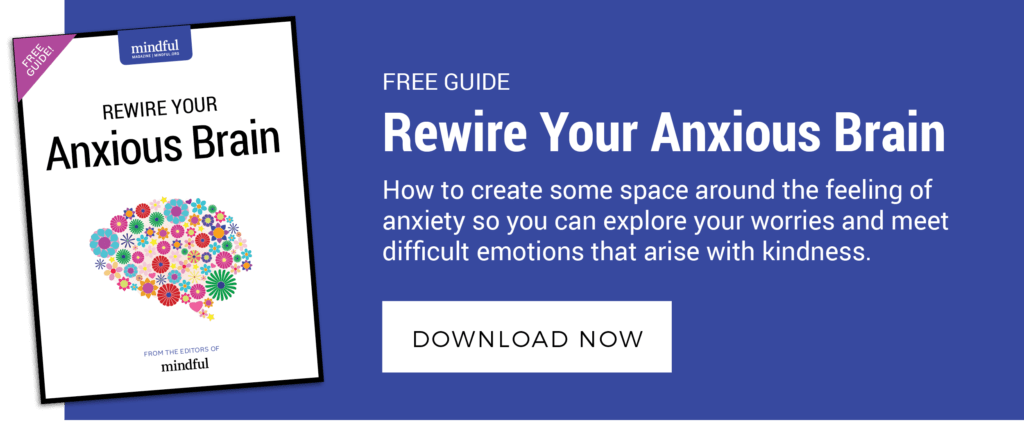This practice combines mindful breathing, the body scan, and mindfulness of thoughts with mindful self-inquiry. Mindful self-inquiry is an investigation into the nature of one’s own mind and being. That inquiry looks into physical sensations, emotions, and thoughts that may be contributing to stress and anxiety. In your daily life, you may be so busy doing that you feel you have little or no time for self-reflection. Yet this exploration is extremely worthwhile, as fears often lie beneath the surface of awareness.
By going with what’s happening rather than expending energy fighting or turning away from it, you create the opportunity to gain insight into what’s driving your concerns.
When you practice mindful self-inquiry, you bring kind awareness and acknowledgment to any stressed or anxious feelings in the body and mind and simply allow them to be. This means staying with those feelings without analyzing, suppressing, or encouraging them. Although this may seem scary in and of itself, realize that when you allow yourself to feel and acknowledge your worries, irritations, painful memories, and other difficult thoughts and emotions, this often helps them dissipate. By going with what’s happening rather than expending energy fighting or turning away from it, you create the opportunity to gain insight into what’s driving your concerns. When you begin to understand the underlying causes of your apprehension, freedom and a sense of spaciousness naturally emerge. In essence, this is a process of learning to trust and stay with feelings of discomfort rather than trying to escape from or analyze them. This often leads to a remarkable shift; time and again your feelings will show you everything you need to know about them—and something you need to know for your own well-being.

To allow you to fully experience this meditation, we recommend that you listen to the audio version. However, you can also simply read the text below. If you choose to do so, read through the entire script first to familiarize yourself with the practice, then do the practice, referring back to the text as needed and pausing briefly after each paragraph. Take about thirty minutes for the practice. You can do this practice in a seated position, standing, or even lying down. Choose a position in which you can be comfortable and alert.
A 30-Minute Anxiety Meditation
A Meditation for Working with Anxiety and Stress
As we begin this practice, let’s take a moment to welcome and congratulate ourselves in being here — that we’re actually taking this time to be present, to go inside, into our own lives.
Let’s take a few moments to feel that we are in the mind and body with a mindful check in: Feeling any sensations, any holdings, any tightness in the body as well as feeling into your mood, feeling into our emotions, and just acknowledging whatever’s being felt and letting be. Just feeling how we are with awareness and acknowledging whatever there is to be felt.
Now very gently, withdrawing the awareness from the mindful check-in, let’s bring our attention to the breath: Being mindful of the breath in the abdomen, expanding on an inhalation and falling on an exhalation. Breathing in and breathing out with awareness. Breathing normally and breathing naturally, feeling the rise and fall of the abdomen. This type of mindful breathing can help calm us down when we are feeling anxious, feeling fearful, so just be mindful of the breath coming in and going out — breathing in and out with awareness.
If we find in the silences that our mind has wandered off, compassionately, gently making them note “wandering” and coming back to the breath and the abdomen, breathing in and breathing out with awareness. Slowing our lives down, taking it one inhalation and one exhalation at a time. Breathing in and breathing out with awareness — breathing in and breathing out, moment to moment.
Now gently withdrawing the awareness from breathing, we’ll shift our focus to a body scan. Feeling into this body, into the world of sensations, thoughts, and emotions, and acknowledging whatever is being experienced — just like a meteorologist will objectively report the weather and the outside, we as mindfulness practitioners are like internal meteorologists reporting the weather objectively on the inside. So whatever it is that we’re feeling in the body, in the mind, let’s just acknowledge whatever is being felt and let be.
Let’s bring the focus of our awareness into the soles of each of our feet, getting to feel the heels, bottom of the feet, the toes, the top of the feet, behind into the Achilles tendon, and gently above into the ankles joints, feeling each of the feet up to the ankles with awareness and just acknowledging whatever is felt in the body or potentially in the mind. Feeling into the feet, into the ankles, letting the awareness rise up into each of the lower legs, and to the calves, the shins, and coming up into the knee joints — feeling into the body with awareness.
Now, letting the awareness rise up from the lower legs and knees into the upper legs, into the thighs, our hamstrings, quadriceps, feeling into the upper legs, and feeling its connection up into the hip joints, feeling sensations, the felt sense of the body. Feeling into the thighs, into the hips, and letting be. Letting the awareness come up into the hips, into the pelvic girdle, into the center of the body, feeling the sit bones, the buttocks, genital region — great systems within of elimination, reproduction — feeling into the center of this body with awareness, within the hips and the pelvic girdle. Whatever arises in the body, or perhaps at times even in the mind and emotions, acknowledging and letting be. Letting the awareness rise into the tailbone and then gently coming up into the lower back, up the spine into the middle, eventually into the upper back, feeling sensations in the back with awareness, and letting be.
As we go through this body we may notice from time to time tensions, tightness, achy-ness, and if we can allow any of these areas to soften, by all means, let that happen. It’s also important to know that if we are unable to soften, our practice informs us to let be. Let whatever sensations ripple and resonate wherever they need to go — the same applies even to our thoughts and emotions, letting them be.
Feeling into the back with awareness, letting the awareness begin rise up into each of the shoulders and the shoulder blades. Then gently bringing the awareness down each of the upper arms, into the elbows, into the forearms, the wrists, and the hands, feeling sensations from the shoulders to the fingertips and letting be.
Withdrawing the awareness now from the shoulders to the fingertips and placing our attention into the belly. Great system of digestion, assimilation, feeling into the belly with the awareness. Whatever sensations that may be felt: tightness, nervousness, “just right-ness” — whatever’s there, acknowledging, and letting be as we feel into our guts, into the belly with awareness.
Now letting the awareness rise up into the skin of the chest, into the breast, to the sternum, and rib cage. Then feeling into the great systems of ventilation, of the lungs, and circulation of the heart. Feeling into the chest with awareness and being mindful of whatever comes up in the body. Letting any waves of thoughts, emotions, sensations ripple and resonate where ever they need to go. Feeling into the chest with awareness.
Now bringing the awareness from the chest back up into the shoulders again. Feeling the shoulders and its connections into the neck and throat, being present.
Now letting the awareness from the shoulders and neck and throat come up into the jaw joint. One of the most exercised joints in the body, home of communication, home of how we take in food — feeling into the jaw, into the mouth, into the teeth, and tongue, and letting be. Feeling into the cheeks of the face, into the sinus passages, into the temples, the head, and the forehead. Feeling into the eyes and the muscles around the eyes. Feeling into the facial structure. Feeling into the top, into the back of the head, feeling sensations, and letting be. Feeling in through the ears, into the inside of the head into the brain. Feeling the face and head with awareness.
Now gently connecting the face and head with the neck and throat, and with the shoulders and arms, and the hands, the chest, the belly, the back, the hips, the legs, and feet, feeling the body as a whole from head to toe fingertip. As we breathe in feeling the body rising ever so gently on the inhalation and falling on the exhalation.
As we’re feeling into this body and mind, we may at times continue to experience some anxious thoughts, worries, fears, and there are times when we can use the practice of mindfulness, of inquiry, of investigating to discover potentially the underlying causes of our fears. If it appears that even after practicing the body scan and mindful breathing that we’re persisting with some anxious feelings, bringing attention to those feelings themselves now to acknowledge what’s being felt, feeling into the fear. As I say this, I want to say this with a word of compassion and gentleness, just like on a hot day if we would like to go swimming and we put our toes into the water and react with such coldness that through the gradual acclimation of dipping the toes in and out of the water we acclimate to the temperature and slowly, part by part, our body becomes accustomed to the temperature of the water and we go swimming. Very gently dipping the toes into feeling the fear, just acknowledging what’s there, letting be, feeling into the fear with awareness — there’s no need to try to analyze or figure things out, just feeling into the experience of feeling anxious, fearful, worried, and letting be. And whatever arise, equally acknowledging and letting be, feeling into the heart of fear.
Just listening with such compassion. No need to push ourselves more than we can handle but just working with the edges, feeling into the anxiety and acknowledging. As we learn to be with things as they are, we may discover the underlying causes of our fear and pain.
As we learn to be with things as they are, we may discover the underlying causes of our fear and pain.
And now gently withdrawing from the mindful inquiry practice. Let’s just come back to the breath again, in and out, feeling in the abdomen the belly expanding on the inhalation and falling on the isolation. Breathing in and breathing out, with awareness. Just staying present to each breath, in and out.
Now just like we’re watching the breath coming and going, we can even begin in this last practice of watching the very thoughts we think like watching the clouds flying by in the sky, like sitting at the edge of a river just watching whatever is floating downstream. Beginning to observe the mind and even the thoughts of fear are nothing but passing mental phenomena, like clouds, observing any fearful, anxious thoughts as just mental events that come and go — being present to the mind. Just thoughts, just like any of the other senses, of sight, of sound, taste smell, body sensations — all coming and going, all showing the mark of impermanence. Observing the mind, thoughts, noticing the ever-changing nature of thoughts showing it’s impermanence. Just coming and going, thinking. As we become aware of thoughts and the traps we find ourselves in that moment, we can become free. Just thoughts.
And now gently withdrawing our awareness from the mindfulness of thoughts, let’s come back to the breath in the abdomen. Just be mindful breathing in and breathing out. Now as we begin to end this meditation on working with anxiety let’s take a moment to remember all those that are being challenged with these feelings, all those living with fear, worry — let us extend our well-wishes of healing, of peace, to all those living in fear.
May we take these moments now to congratulate ourselves of proactively turning into the fears into working with them. May we affirm, as we acclimate ourselves to the fears, that we can not be so challenged by them. May all beings, all those anywhere that live in fear, may we remember to be held in the cradle of the heart of the universe, and that we have not been forsaken. May all being, wherever they are, may they be free from fear, and may all beings be at peace.
This article has been adapted from A Mindfulness-Based Stress Reduction Workbook by Bob Stahl PhD and Elisha Goldstein.
A Guide to Meditation for Anxiety

Meditation for Anxiety
Explore how mindfulness and meditation can help soften feelings of anxiousness, reduce stress, and calm a panic attack.
Read More








